Howard Hall: Tagging - a celebration of science?
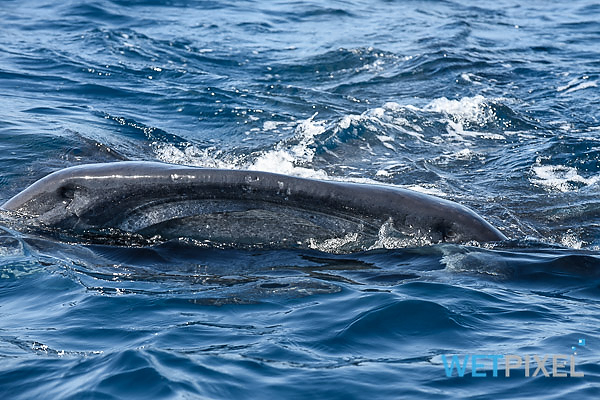
TAGGING: A Celebration of Science
By Howard Hall
The 16mm movie camera in my right hand only weighed fifteen pounds, but it was beginning to seem much heavier as I climbed up the steep face of the coastal sand dune. My other hand was balancing a tripod that was digging deeper into my shoulder with every step. I really wanted to stop and rest but the top of the dune was only another few minutes away and I didn’t want to set the camera down in the sand.
I reached the top of the dune and was relieved to find that it offered a perfect perspective looking down the long curving beach. Covering the sand were hundreds of enormous elephant seals (Mirounga angustirostris) - the reason I had come to this spot in Northern California. I planned to work here for about a week, filming courtship behavior and territorial fighting of these spectacular pinnipeds.
The early morning light was perfect and I decided to start with a long establishing shot showing the entire beach. Then using a telephoto lens, I would capture a variety of medium shots that compressed hundreds of seals against the breaking waves. Once satisfied with the establishing shots, I would move closer to spend the rest of the day filming episodes of fighting, mating, and females nursing young.
I mounted and levelled the camera on the tripod and then used a small dry paintbrush to dust-off the sand that had accumulated on the camera. One grain of sand in the camera gate is plenty to ruin a roll of film. Then I uncovered the 12-240mm zoom lens and looked through the viewfinder simultaneously twisting the zoom to 240mm in order to set focus. When the image clarified it revealed a large male elephant seal lying in the sand surrounded by dozens of smaller females. Thirty yards behind the male another smaller male was crawling out of the surf. The larger male suddenly rose on its forward flippers to confront the intruder. Wow, this is great! I reached for the camera run switch then stopped when I saw the “Lizard.” Painted on the side of the large male elephant seal, in letters that spanned the width of its body in day-glow green fluorescent paint, was the word “Lizard.” What the hell? I removed my finger from the run switch and refocused on the smaller male leaving the surf. Damn! Apparently, his name was “Buster.”
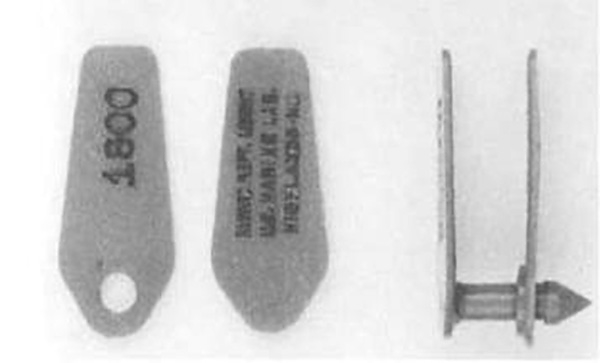
I hurriedly surveyed the other animals on the beach. I couldn’t believe it. Nearly every male elephant seal had been painted along with many of the smaller females. There was essentially no way to get a shot without including a hideously marked animal. I looked up from the camera and at the sandstone bluffs behind the seal rookery. Surprisingly, no one had painted their names on the sandstone walls, nor did I see large signs erected to mar the beauty of the coastal highway. No, all the graffiti was confined to the wildlife.
After spending a couple hours confirming that there was no way to capture the elephant seal sequence that I had come for without including flamboyantly disfigured animals, I packed up my gear and headed south toward San Diego and home. Of course, I knew what had happened. Some scientist, probably in pursuit of publishing a masters or doctoral thesis, was conducting a study of elephant seal movements perhaps to learn more about their territorial behavior within the rookery. And, of course, I knew that in order to save these wild animals it was important to learn everything possible about their migratory behavior.

On a small inflatable boat in San Ignacio lagoon I struggled to hold my movie camera still as the large gray whale (Eschrichtius robustus)approached. Even though the water was calm and my lens was very wide, it was difficult to hand-hold the camera still enough to do professional wildlife work – at least for my taste. As the whale approached, a small white butterfly drifted over its back fluttering against the gentle breeze. It was a beautiful shot. Fortunately, I had just switched the camera off when another explosion caused me to instinctively duck. After a week in the lagoon, I should have been prepared for the noise.
The scientists were also working from a similar if not somewhat larger inflatable boat. They had erected a teeter-totter-like device that was mounted on the pontoons and supported a long fiberglass boom. At the end of the boom hung a coffee can-sized device that was held about six feet above the water by an operator on the other end of the boom. When the scientists approached a whale closely enough, or when a “friendly” whale approached their boat, the boom was released by the operator allowing the canister to fall on the back of the whale where upon it detonated with a small (for a whale maybe) explosive charge. The explosion sent out a spider web of cables beneath the animal’s skin anchoring a transmitter and antennae to the whale’s back. The discomfort to the whale was really almost insignificant – for us sort of like being stung by a wasp. Those of us who have experienced wasp stings know that it’s really not that big a deal. Nevertheless, the gray whales tend to react with a fair amount of rather violent splashing around and immediate acceleration in the opposite direction.

Of course, it’s critically important to understand the movements of these large endangered animals if we hope to protect them. In this case, however, we learned primarily that whales, once so adorned with embedded transmitter and radio antennae, invariably descend immediately to the lagoon floor, turn upside down, and then rub the transmitter off in the mud. Although this observation may not have been worthy of a master’s thesis, I suspect the incidents did serve to correct any further aberrant “friendly” behavior by those particular whales.
In Dominica a scientist explained to me how dangerous filming whales can be for the animals. Whales use enormous amounts of energy to swim – energy that must be replenished with limited food resources. A diver entering the water in a whale’s path often causes the whale to divert its course, the additional expenditure of energy beyond what would naturally be spent otherwise must necessarily, even if only in a small way statistically, negatively influence the animal’s survivability. Certainly, this makes a great deal of sense to me and so I explained that inserting myself in a whale’s path seldom results in a useful shot anyway. So I don’t use that technique. In fact, nearly every shot I’ve captured of gray whales, right whales, humpback whales, and (in this case) sperm whales were accomplished when the animals became interested in me, or my boat, and diverted their course for an inspection sometimes hanging around for hours. The scientist explained, however, that even this diversion from feeding is unnatural, energy expensive, and could influence the animal’s ability to survive. I admitted that I really hadn’t considered that and decided, technically, it was probably true.
Of course, it also occurred to me that the expenditure of energy sperm whales experience when being chased by this particular scientist’s boat or in response to the impact of the bow-mounted harpoon gun he used to implant transponders might also be significant. Certainly, the impact was far from life-threatening and only served to mount a transmitter to the animal via small (to a whale anyway) dart and thin (relatively) steel cable. In fact, this would probably feel like little more than a wasp sting would feel to us (in this case perhaps a rather large wasp). More importantly, any loss of survivability of each whale tagged with a transmitter is more than redeemed by the knowledge gained about sperm whale behavior. We can’t protect these animals unless we know what they do and where they go.
On the Silver Bank the technique for proper in-water observation of whales was reinforced when explained to us by another team of scientists. Additionally, it was explained that the use of SCUBA has a very negative impact because the bubble noise frightens the animals. And frightened animals tend to run away unnecessarily expending large amounts of critical energy. Indeed, I noticed this tendency for frightened whales to expend large amounts of energy every time the scientific team ran their inflatable up on a humpback whale’s back at high speed and shot it with a crossbow. Despite the very small hole caused by the arrow, little more than an equivalent bee sting, the whales would splash, dive, and run like crazy while the scientists would whoop and holler like cowboys on roundup. It really did look like buckets of fun (for the scientific team, if not the whales).
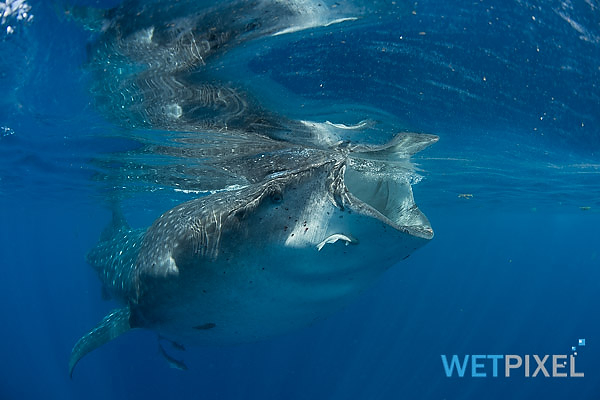
During the season, this methodology allowed the scientific team to remove over a hundred small bloody plugs of skin and blubber from the Atlantic humpback population that over-winters on the Silver Bank. The ensuing DNA analysis allowed the scientists to learn a great deal about the population dynamics of Atlantic humpbacks, information that will be invaluable in publishing articles, masters theses, and even doctoral theses that will be critical for saving the species. The crossbow procedure also helped to correct the aberrant tendency for some whales to demonstrate “friendly” behavior.
On the El Bajo seamount in the Sea of Cortez something was finally learned about the mysterious schooling behavior of hammerhead sharks. This was accomplished by tagging as many of the sharks as possible with numerical tags as well as transmitters. Movements of the sharks were then monitored with the use of receivers suspended on buoyed lines high above the bottom. Unfortunately, this methodology was often interrupted when manta rays became tangled in the buoy lines. The death of the mantas was unexpected and distressing to everyone diving at the seamount at the time including the scientists. But it was certainly worth it. We learned that some of the sharks stay at the seamount all night while others descend to feed primarily on squid, almost certainly in response to getting hungry. That squid was the primary food resource was confirmed by doing exhaustive stomach contents analysis. How this information might have been useful in protecting schooling hammerheads may never be known since most of the sharks and the remaining mantas were all fished out commercially in the few years that followed.

Film and processing is amazingly expensive when shooting in the IMAX format. This is especially true when working in IMAX 3D. Each 7-minute load of film costs more than $20,000 to purchase, process, and print. So when making the film Into the Deep, I had to be especially careful to avoid filming animals that were aesthetically unacceptable. This problem was most significant as we attempted to capture a lovely sequence of California sea lions (Zalophus californianus)for the film.
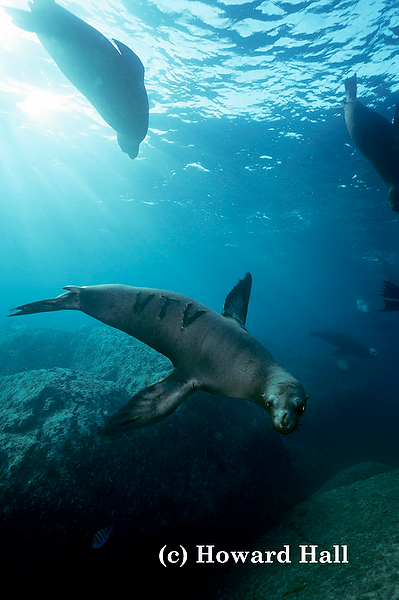
Eighty feet below the surface at San Miguel Island sea lions were chewing the tops off of palm kelp plants. I had never seen this behavior before and as far as I know it remains unexplained today. It was potentially a great sequence for the film. But each time I trained the camera on one of these lovely animals, a disfigured one would swim into frame ruining the shot. First it was sea lion number 2383 then it was sea lion 3134. It was easy to tell what number the animal was because the number had been hot-branded into the animal’s flesh in figures fully the width of the body. Now you would think that huge numbers permanently burned into an animal’s flesh would be sufficient to identify any given sea lion. But I also noticed that many sea lions had an additional plastic tag (with a different number) mounted via a hole punched in their front flipper. The explanation for the two numbers was probably that two numbering systems were being used by two different scientific studies. Fortunately we managed to find and film enough unblemished animals to make a nice sequence for the film.
Of course, Into the Deep was made a long time ago – more than years now - when there were lots of unbranded sea lions swimming around. Now it may be a bit tougher. The National Marine Fishery Service sponsors the hot-branding of thousands of sea lion pups each year. Using a hot branding iron seems a bit cruel. But I have been told that if you brand baby sea lions, before their nerve endings are fully developed, the pain is not significant. And most of the time the burn heals without causing life-threatening infection. Furthermore, all the writhing and screaming performed by the baby animals is scientifically called “avoidance response” and should not be confused with pain as we know it.
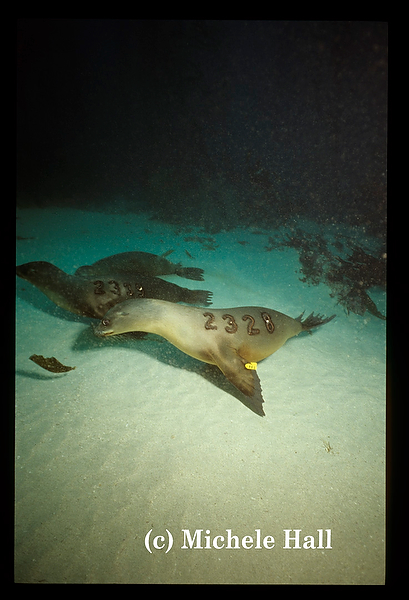
Branding a few thousand baby California sea lions is no big deal, because there are so darn many of them. But a few years ago a Federal judge issued a ruling preventing the National Marine Fisheries Service from hot-branding several thousands baby Steller sea lions (Eumetopias jubatus). Stellar sea lions are, after all, an endangered species. The judge thought it might be a good idea to investigate the impact of hot branding an endangered species before conducting the research. This is a real shame. How will it be possible to protect these animals when we know so little about them? And how can we keep track of individual animals unless we have a good numbering system? Perhaps the judge has a point, however. Perhaps it might be a good idea to conduct a preliminary study to determine the effects hot-branding has on baby sea lion mortality before we risk impacting the Stellar population. I suggest this could be done easily by conducting a scientific study using green fluorescent paint to mark up a few thousand baby California sea lions (as I mentioned, there’s lots of those) then hot-branding a few thousand more. We would then punch plastic tags in all of the baby sea lion flippers for further identification. Then the statistical difference in mortality between the two populations could be measured to see if it is significant. Certainly, this study is worthy of someone’s master’s thesis.

Of course, I would rather that any numbering system for keeping track of our wildlife be aesthetically attractive. Hot-brands are really quite unsightly especially when portions of the brand are infected. And because the brands are so large, even photographers who are skilled at Photoshop will have difficulty removing the numbers from digital images of sea lions. For the most part scientists do a much better job with sea otters. Hot-branding sea otters is really out of the questions since otters with intact pelts are such a major tourist attraction for the city of Monterey. All it would take would be one dead otter washing up on the beach with a putrefied hot-brand, and that would be that. Instead, many otters are tagged with subcutaneous electronic tags plus an ear tag plus a large and colorful plastic tag in each rear foot. Why so many tags are necessary requires a more detailed scientific explanation and is beyond the scope of this essay (which is to say I haven’t a clue). I’m told, however, that videotaping of the tagging procedure is strictly prohibited because the “avoidance response” associated with punching holes through otter feet can be easily mistaken for excruciating pain.
Despite the occasional unpleasantness, it is critical that tagging and transmitters remain a major part of what marine biology masters candidates and doctoral candidates do. We have learned wonderful things from tagging programs. Recently white sharks tagged in California turned up swimming at 1,000 feet in the waters off Hawaii! No one could have predicted that. And when filming great whites at Guadalupe Island last year, knowing about these trips to Hawaii made waiting for an untagged shark to swim by quite tolerable.
To some degree tourism itself benefits from tagging programs. There are several shark-tagging programs that are used as much to attract sport divers as they are to create useful migratory data. It seems to be great fun to watch or even participate in the process of sticking animals with dart-tipped spears. And without tagging, what would all those heroic death-defying scientists do during Discovery’s Shark Week or on National Geographic shark shows? Indeed, in the late 1970’s and early 1980’s Shark Tagging Competitions and phony-baloney Wild Kingdom pseudo-scientific tagging expeditions helped me afford a down payment on my first home! Why shouldn’t other sport diving operations benefit? Oh, sorry, you didn’t think the science being conducted on all of those shows was real, did you?
Clearly, as human population increases and wildlife populations plummet, it will be increasingly important to know where every animal is in our oceans at any given time. There is a program currently being funded that should accomplish just that. The Census of the Seas project is a one billion dollar program designed to get an accurate count of what’s living in our ocean. This program will start modestly by placing 4,000 transmitters on everything from blue whales to leatherback turtles. The program’s ultimate goal is to tag pretty much every large animal in the sea. Only after every animal has been tagged and properly numbered can we hope to know enough about their migratory patterns to prevent their extinction, or at least know a little about them before commercial fisheries remove them all with nets and long-lines. There is not a moment to waste. The decline of wildlife populations in our oceans is accelerating dramatically. At the same time there is an ever increasing population of scientists, filmmakers, even sport divers armed with tags, transmitters, DNA sampling devices, crittercams, and millions of dollars in funding for marine life population dynamics studies. If we procrastinate too long there may be more scientists, tags, crossbows, branding irons, and transmitters than there are animals to be numbered. If we act now, perhaps we can get every animal tagged or branded before it’s too late.
Hopefully, sometime in the very near future, filmmakers like me will no long turn their cameras away from animals they consider disfigured with tags, brands, or transmitters, but will instead consider unadorned animals as unworthy, unnatural, even obscenely naked. Soon we may all look askance at a big horn sheep that does not have a beer can-size transmitter strapped around its neck, or a monarch butterfly without a number taped to the top of each wing. And hopefully, someday soon our government will change sanctioned illustrations our national symbol to show bald eagles with bands on their legs and large numbered tags under each wing just as they appear today in nature (anywhere in the lower 48 states). Then when one of us is out in the wild and sees a rare bald eagle the wilderness experience will fully meet our happy expectation.
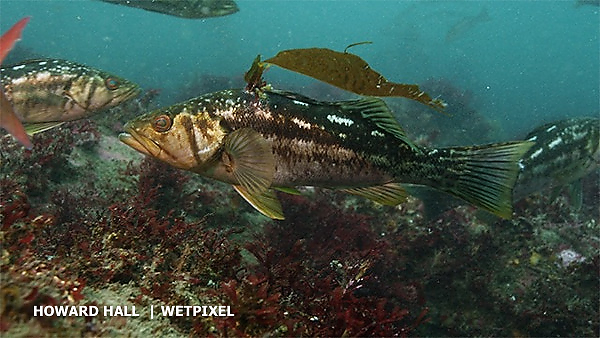
On a recent dive at La Jolla Cove in San Diego, California, I noticed a small kelp forest swimming across the bottom. After a few minutes, I noticed several more small forests in motion. It turns out that kelp bass (Paralabrax clathratus) are being studied in the La Jolla Marine Reserve. The tags embedded near the dorsal fins of kelp bass had become encrusted with algae and in many cases Macrocystis pyrifera, or giant kelp. I wondered how well a kelp bass so encumbered would be able to hunt and evade predators. I also wondered if any population studies of the La Jolla kelp bass took into consideration the impact of the study itself. I look forward to diving in La Jolla again this spring to see if any of the tagged kelp bass are left.
A post-graduate credential often qualifies marine biologists for permits allowing the tagging of endangered animals as well as species in marine protected areas. As sport divers we generally celebrate these programs and accept the damage done to wildlife as a justified sacrifice in an effort to conserve ocean habitat and species. And I am sure many of these programs are critical in that regard. But I also suggest that, as members of the sport diving community, our acceptance should not be blind.